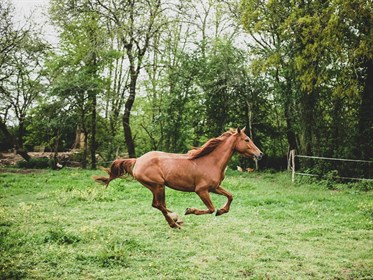
This article first appeared in a previous edition of Equestrian Life magazine. To see what is in our latest digital issue, please click here.
Horses are a flight animal.
Part I: Fight, Flight or Freeze
By Dr Kerry Mack
Humans and horses have much in common. In fact, on the evolutionary tree we are very close. Being mammals we share a great deal of anatomy and physiology. Our DNA is almost identical, our skeletons are similar, and our nervous systems have a great deal in common. We both have finely tuned physiological responses to stress, mediated by the stress hormones, adrenaline, and cortisol. Most of us experience this as anxiety.
Stress is defined as pressure or tension exerted on a physical being, or a state of physical or emotional tension resulting from adverse or demanding circumstances.
These physiological responses have evolved to help us (horse and humans) function better at times of stress. Sometimes this stress response is called the Fight and Flight response. When our stress systems are activated, we can fight or run away more effectively.
Our autonomic nervous system is the part of our nervous system that controls our body's automatic functions such as blood pressure and heart rate. In short, the sympathetic nervous system winds us up to fight or run away; the para-sympathetic nervous system winds us down if we are exposed to stress where the best response is to freeze, or after a fight/flight stress when we are recovering. There is an optimal range where we are likely to function best. Too stressed and we get jittery and can't concentrate. Too frozen and we don't take information in and are not sharp. But generally the stress response helps us.
I believe it's very helpful to understand the basics of the stress response and how it applies to horses and people. We all know that we can easily get stressed in the course of competitions and other aspects of horse riding. Also, much of what we ask horses to do can be stressful for them, especially initially. Studies have been done documenting that horses find travelling, and competing stressful.
Experienced show jumpers have been shown to be less stressed at horse shows than training jumpers, for example. It is easy to measure a horse's stress response by taking blood and measuring cortisol, or measuring heart rate and recovery.
The Yerkes Dodson Curve explains the relationship between stress and performance in humans. This relationship has been shown in many situations, including tests of strength, speed of response, complex tasks such as driving and so on. When we are not stressed we do not function all that well. We are not quick or strong when we are relaxed. Imagine you are lying around the resort swimming pool and someone yells "fire". You don't stroll off in the relaxed stupor of sunbaking. A structure deep in the brain called the amygdala is our danger detector. The amygdala fires off, adrenaline is released. The amygdala is a structure that learns from experience. If something happens that resembles a stressful situation in the past, the amygdala fires off. You feel the surge of adrenaline that can be almost like an electric shock; you are immediately alert and taking in everything around you. You may feel your heart beating in your chest (palpitations). Your mouth goes dry, you may feel short of breath. Your muscles are tight and your stomach may churn. You are physiologically primed to run away or to fight. When people are very stressed they are stronger and faster than normal. People jump big fences to escape fire, lift weights beyond their usual strength to free someone who is trapped, and win gold medals and break world records. This is the state we want to be in to achieve peak performance when competing. In short, some stress and anxiety helps you perform at your best.
We do, however, have a peak level of performance. If the stress levels keep going up we can become overwhelmed and function less well. We may experience a panic attack. When the palpitations and shortness of breath and other physiological symptoms become so intense we may believe we are having a heart attack. In fact, panic is a very common presentation to casualty departments. The person will look very much as if they are having a heart attack. The ECG will show a fast heart rate but no actual heart attack (no problems with the heart muscle or blood supply).
Sometimes when we are stressed we freeze. We see this often with frightened children. They just stop in their tracks, motionless. It's like the rabbit in the spotlight, so overwhelmed by the experience of anxiety that they don't move. If humans get more anxious than this we can dissociate. This is the experience of seeing what is happening as if you are not involved, sometimes described by victims of rape and torture. Pain is often not experienced in this state. This is still a survival response. There are stresses where fighting or running away won't help you. Freezing, being submissive, may help by not provoking an aggressor, whether it is a lion or an angry spouse or parent. It helps when confronted by some predators, as they might not see you. Snakes, for instance, see movement not shapes, so if you stand still a snake actually won't see you and will forget you are there! Horses will often freeze for a moment to check out something frightening when they are stressed before they run away.
So, we want to be at the top of the Yerkes Dodson Curve for peak performance. You do not want to be over the top where stress interferes with performance. You will see that stress is cumulative. For example, you start the day a bit tense in anticipation. You may be running late (more stress) and then he doesn't want the bridle on (more stress). You start to have a dialogue in your head that it isn't your day. Then a steward gives you a hard time about something trivial (more stress) and you snap. You can see that managing stress is an important skill for the rider to develop. Understanding the mechanism, and noticing it – developing the capacity to notice and reflect on your experience and do something about – it is essential.
Horses are a flight animal. They evolved on the plains of Europe and were hunted by the big predators, including humans. They are very sensitive to perceived danger. Unfamiliar objects, noise and smells or unexpected movement can all trigger the amygdala, the danger detector, and thereby trigger the stress (fight, flight and freeze) response. Riders will be very aware of this. You can easily feel a stressed horse's heart thumping under your legs, and we all know that the next thing could easily be that he will run away.
Temperament and past experience will influence the stress response. Thoroughbreds and Arabs tend to stress more easily that Warmbloods. Some horses are naturally more timid than others. A horse that has been frightened by something in the past will be more sensitive to that trigger unless the time has been taken to habituate it horse to the cause. Habituate means to learn to ignore stress or pressure. For example, we expect a horse to habituate to the pressure of the girth when we break them in. We expect that when we take a horse to a show for the first time, he will be very alert and on edge (vigilant, stressed) for a while before he settles down. It is exposure to stress (e.g. the girth, the horse show) and then the experience that nothing bad happens which habituates the horse to these types of stress. He learns that these things are not actually dangerous, so the amygdala doesn't fire off.
It is really important that we help him to get used to these stresses by – where possible – gradually exposing him to these things and then layering up the experiences. Repetition is the tool of learning. Repeated exposure to a stress with a good outcome will build confidence. This is why it is extremely poor horsemanship to put more pressure on a young horse that is stressed. For example, if he is at his first show and won't stand still at the float (he is stressed and would like to run away but is tied up) it will not help to hit him to try to get him to stand still. He will only think that there is even more reason to be frightened. He is likely to take a longer time to settle down, and may become convinced that shows are dangerous places.
Human brains have great big frontal lobes sitting above our eyes. This is where we our brains use logic and reason, and language. We are able to calm down our amygdala by thinking about the lessons of our past. Something may seem dangerous but we can calm ourselves by recognising that it isn't actually dangerous. Horses, on the other hand, like all other animals, have very limited frontal lobes, no language like ours and they can't use reason to calm themselves down.
READ THE LATEST NEWS ARTICLES HERE
https://www.equestrianlife.com.au/articles/Part-I-Fight-Flight-or-Freeze

